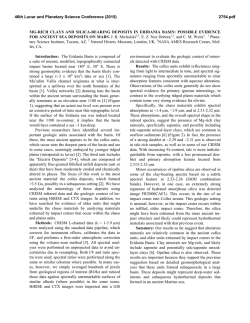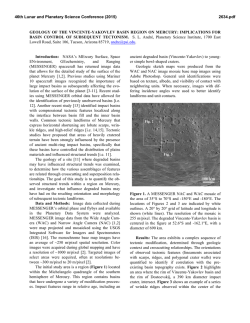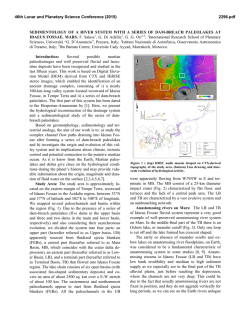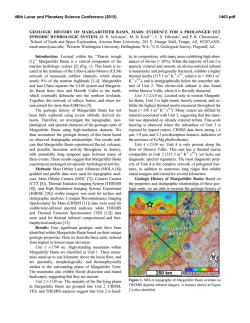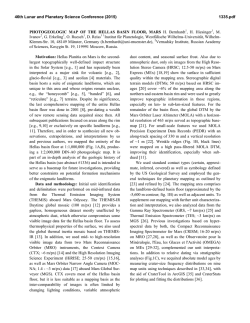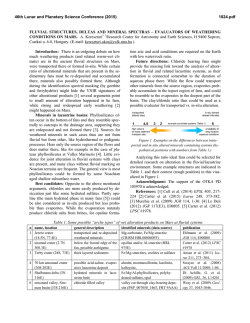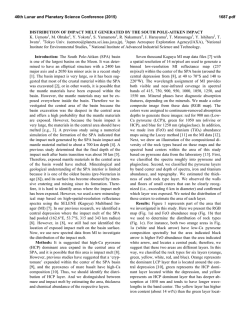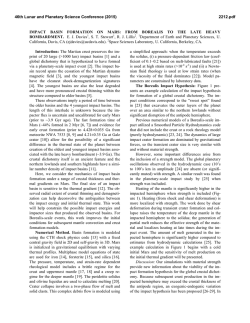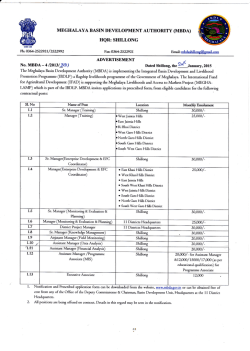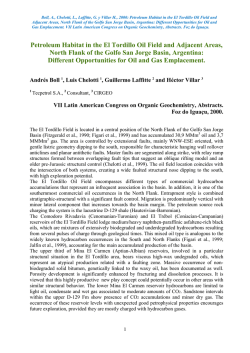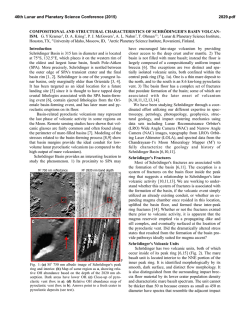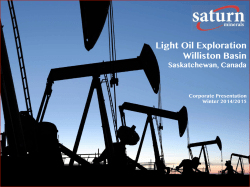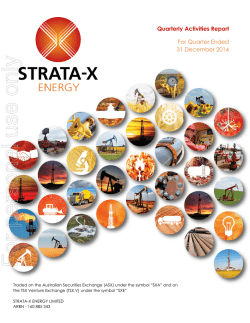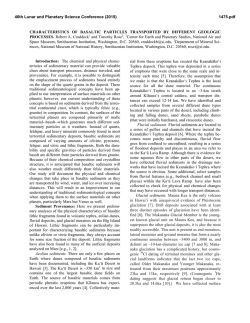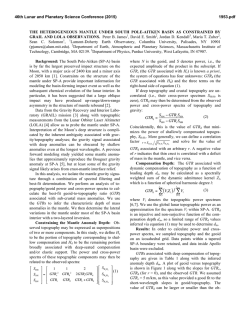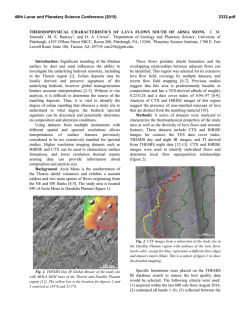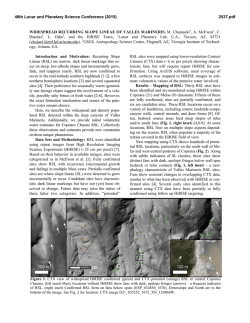
Stratigraphy Evidence of Episodic Fluvial Activity in the South Melas
46th Lunar and Planetary Science Conference (2015) 1932.pdf STRATIGRAPHIC EVIDENCE OF EPISODIC FLUVIAL ACTIVITY IN THE SOUTH MELAS CHASMA BASIN, VALLES MARINERIS, MARS J. Davis1, 2, P. Grindrod2, 3, R. Williams4, S. Gupta5, and M. Balme6. 1 Dept. of Earth Sciences, University College London, London, UK; [email protected], 2Centre for Planetary Sciences at UCL-Birkbeck, University College London, London, UK, 3Dept. of Geology and Planetary Science, Birkbeck, London, UK, 4Planetary Science Institute, Tucson, AZ, USA, 5Dept. of Earth Science and Engineering, Imperial College, London, UK, 6Dept. of Physical Sciences, The Open University, Milton Keynes, UK. Introduction: The South Melas basin is an enclosed topographic depression hanging on the southern wall of Melas Chasma, Valles Marineris. It is widely recognised to have been host to past aqueous activity [1, 2]. Central to this interpretation is what appears to be evidence of a palaeolake that is approximately 45 by 25 kilometres in size in the eastern half of the basin. The South Melas basin contains a complex stratigraphy, which includes a series of sedimentary fans located on both the east and west side of the basin that originate from a network of valleys. Previous work has suggested that both the fans and the valley networks had an aqueous origin [1, 2]. It was recently proposed that the basin could have undergone multiple aqueous events throughout its history [3]. Our work builds on this interpretation by examining the stratigraphy within the basin at high resolution and characterising the valleys network to the east. Methods: The South Melas Basin has exceptional image coverage in both CTX and HiRISE due to its candidacy as a landing site for MER, MSL and Mars 2020 [4]. These data were used to map the stratigraphic succession and the extent of the eastern channel networks at a greater resolution than previous work. Stereo pairs were also used to produce digital elevation models (DEMs) according to the method of [5] at a resolution of 20 m/pix for CTX and 1 m/pix for HiRISE. In total, we used 10 CTX and 18 HiRISE DEMs to determine stratigraphic relationships and make structural measurements within the basin. Results and Discussion: Basin and Stratigraphic Succession. We mapped the basin-fill succession layer by layer at HiRISE resolution to characterise variation in facies. The frequent variation in sediment texture throughout the sequence, from smooth and flat to rough, polygonalised and mottled, at both the western and eastern edges of the basin suggests that many further fan deposits are mixed in with the lacustrine sediment. This trend is particularly clear in the lower half of the sequence; less so in the upper half. Additionally, several fan-limb and lobeshaped mounds have been found at the basin floor that may be the remnants of larger, more extensive fan deposits that are more resistant to erosion. Midway up the sequence, there is a noticeable change in the dip direction of the lacustrine stratigra- phy (Figure 1). This could be an angular unconformity, representing a break in lacustrine deposition and a drying-out of the basin, during which subsidence and/or erosion of the sediment may have occurred. Stratigraphically, the aqueous fans on the eastern margin of the basin lie on deposits above the unconformity, whereas the aqueous fans on the western margin lie below it. Figure 1: Dip direction at the bottom of the image is to the NE (down sequence); dip direction at the top of the image (up sequence) is S-SE. Evidence for a break in deposition is supported by the occurrence of an exhumed palaeo-dune covered layered, identified by [3] at a similar stratigraphic position within the succession, which has been interpreted as an ancient aeolian dune field. This indicates subaerial exposure, presumably caused by the desiccation of the lake. Eastern Valley Networks. Previous work at MOC and THEMIS resolutions found the valley networks to the east of the palaeolake to be poorly integrated systems with low drainage densities [1]. These valley networks are in contrast to those to the west of the palaeolake, which are fourth to fifth order systems, consistent with surface runoff and precipitation, and more representative of a poly-phase fluvial system (i.e. they comprise of long, (i.e. they comprise of long, broad and shallow channels that then have been incised by more narrow and deep channels). 46th Lunar and Planetary Science Conference (2015) 1932.pdf Figure 2: Channel map of eastern valley networks. Channels are marked by red lines; channels which contain bright-toned deposits or show inverted characteristics are marked in yellow. The black line shows the inferred palaeolake boundary. Arrows show flow direction, divided by the watersheds (green). We have produced a new channel map (Figure 2) at HiRISE and CTX resolution that shows the eastern valley networks to be more developed than previous work suggests. The valley networks and channels are fourth to fifth order systems, have high drainage densities, and show well defined drainage divides. Although the eastern valley networks are not as well preserved as the western valley networks, they show many of the same characteristics, which have been used to infer poly-phase fluvial activity in the western networks [3]. Figure 3: Bright-toned deposits left by the narrow channels. The deposits on the right show inverted characteristics. Furthermore, the narrow and deep channels in the east are surrounded by bright-toned material, similar to deposits on the western channels. In some cases, this material makes up the bulk of the channel itself, and appears to show tendencies towards inversion (Figure 3). Channel inversion means that differential erosion has exposed the channels as inverted relief. Further downstream, some channels have deposited similar material on the canyon wall rock. Our map also shows that some of the eastern channels can be correlated to specific fan deposits at the eastern edge of the palaeolake. The bright deposits are also found in these channels, suggesting that the fan may have formed in one of the later fluvial phases in the basin. Summary: The reflection in the shift in channel characteristics on either side of the basin indicates that water may have been flowing concurrently into the palaeolake from both the east and the west. If this were the case, any localised precipitation that could be responsible for the surface water would be across the entire ~ 300 km2 area. Williams and Weitz [3] estimated a formation time of 102-105 years for the delta and submarine fans structures in the eastern and western parts of the basin. An unconformity lying between these two groups of fans could mean that there were at least two periods of sustained fluvial flow into the palaeolake. References: [1] Quantin et al., 2005, JGR 110 E12S19; [2] Metz et al., 2009, JGR 114 E10002; [3] Williams and Weitz, 2014, Icarus 242 19-37; [4] Williams et al., 2014, Mars 2020 Landing Site Workshop, Crystal City, VA; [5] Kirk et al., 2008, JGR 113 E00A24.
© Copyright 2026
